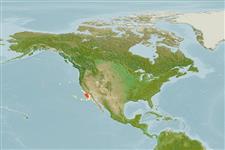>
Saccopharyngiformes (Swallowers and gulpers) >
Monognathidae (Onejaws)
Etymology: Monognathus: Greek, monos = one + Greek, gnathos = jaw (Ref. 45335).
Eponymy: Dr Elbert Halvor Ahlstrom (1910–1979) was an ichthyologist and biologist who spent more than four decades working for the National Fisheries Service. [...] (Ref. 128868), visit book page.
Environment: milieu / climate zone / depth range / distribution range
Ecologia
marinhas bentopelágico; intervalo de profundidade 0 - 2000 m (Ref. 58018). Temperate
Eastern Central Pacific: California, USA.
Tamanho / Peso / Idade
Maturity: Lm ? range ? - ? cm
Max length : 4.9 cm TL macho/indeterminado; (Ref. 34506)
Mesopelagic (Ref. 96339).
Life cycle and mating behavior
Maturidade | Reprodução | Desova | Ovos | Fecundidade | Larvas
Hubbs, C.L., W.I. Follett and L.J. Dempster, 1979. List of the fishes of California. Occasional Papers of the California Academy of Sciences, San Francisco, California, USA, No. 133, 51 p. (Ref. 7182)
Categoria na Lista Vermelha da IUCN (Ref. 130435: Version 2024-1)
Ameaça para o homem
Harmless
Utilização humana
Ferramentas
Relatórios especiais
Descarregue XML
Fontes da internet
Estimates based on models
Preferred temperature (Ref.
123201): 4.5 - 7.7, mean 5.4 °C (based on 16 cells).
Phylogenetic diversity index (Ref.
82804): PD
50 = 0.5001 [Uniqueness, from 0.5 = low to 2.0 = high].
Bayesian length-weight: a=0.00102 (0.00046 - 0.00225), b=3.06 (2.88 - 3.24), in cm total length, based on all LWR estimates for this body shape (Ref.
93245).
Nível Trófico (Ref.
69278): 3.2 ±0.5 se; based on size and trophs of closest relatives
Fishing Vulnerability (Ref.
59153): Low vulnerability (10 of 100).
